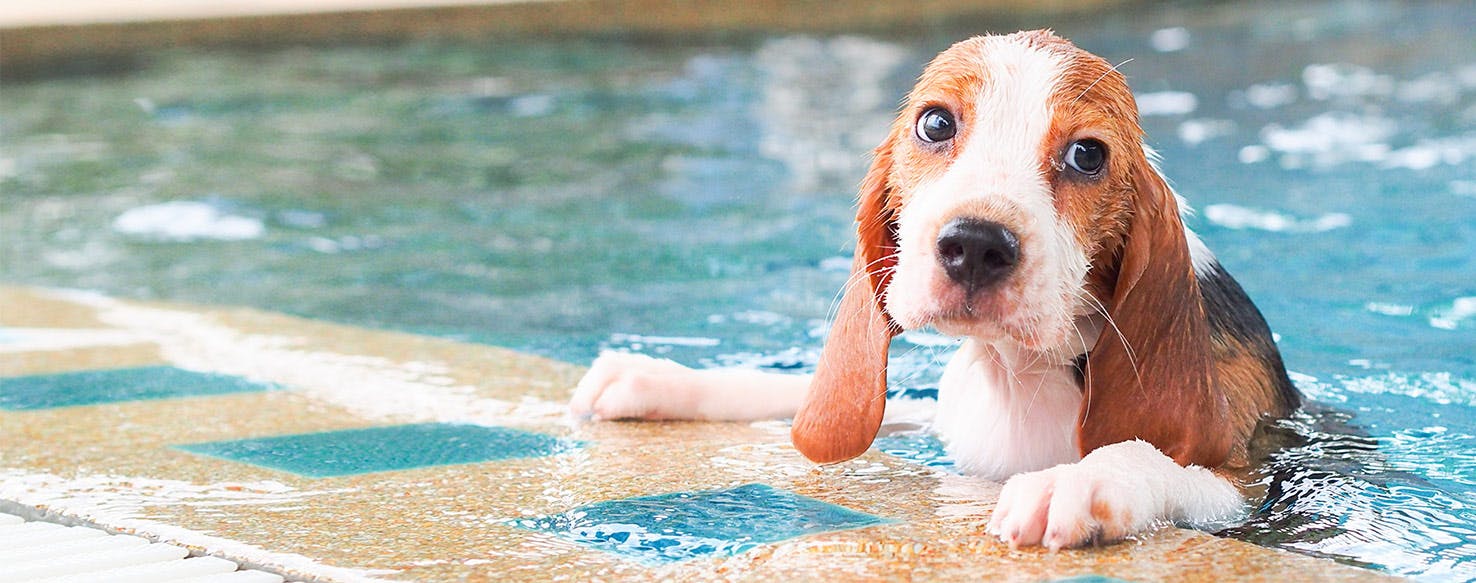- Home
- The Daily Wag!
- Senses
- Can Dogs Swim?

Yes! Dogs can swim and they are good swimmers at that. Just as humans learn to swim, dogs do as well, and they can actually pick it up much faster. Many dogs know how to swim the first time they even step foot into a pool or other body of water.
Dogs will go right into doggy paddle style swimming and it can be pretty cute to watch. With more practice, your dog will become a better swimmer and they will look much less splashy and frantic when they are in a pool or lake.
Most dogs can swim, but there are some larger breeds of dogs that cannot swim or will have a much harder time staying afloat than others. If your dog knows how to swim the first time they are put into water, it does not mean that they can keep their bodies afloat in the water for extended periods of time.
Even though your dog may go directly into doggy paddling in the water, they will likely tire out fast and struggle to keep swimming for extended periods of time. Actual, safe swimming will take some time and practice for your dog to master, just as it is when you learn to swim for the first time.
If your dog does know how to swim, after some practice they will be able to paddle without splashing frantically, they will enjoy being in the water, they will be alert, and will not try to rush out of the pool as quickly as they possibly can. If your dog does not know how to swim or they cannot swim, they will generally panic and splash around with their paws to stay afloat. They may also be very fearful of the water.
Body Language
These are some signs you may notice if your dog can swim:
- Alert
- Wag Tail
- Head Bobbing
- Ears Up
Other Signs
Here are some other signs you may notice if your dog can swim:
- Calm Behavior
- Not Splashing
- Liking The Water
- Staying Afloat
While many dogs tend to be natural swimmers, they are not as good at swimming as many other mammals and other types of animals are. There have been a few studies done on why dogs swim the way they do - using the all-too-famous doggy paddle. It was found that dogs of all different sizes, from a Yorkie to a Newfoundland, all swim with the same doggy paddle style and they do not veer away from this kind of swimming technique.
The dog's legs move forward and move back in parallel with each other. They describe the movement as if the dog were trotting on land, but they are moving their legs and paws much faster when they are in the water.
Many dogs owners claim their dogs love to swim and they were able to learn how to swim without much direction. This is likely due to the fact their ancestors had to swim across ponds, likes, and river to migrate or hunt for their food. Wolves would sometimes catch fish in bodies of water as well, as a source of food, so they would have to know how to effectively maneuver through the water to catch their fish for meal time.
Frank Fish, a biologist at West Chester University in Pennsylvania, did a one-of-a-kind study that analyzed how dogs used the doggy paddle to swim. Although the doggy paddle style of a swim is used to describe how dogs and many other mammals swim, the actual movements taking place were never definitively defined.
This study used 8 dogs from 6 different breeds. Researchers used scuba gear to videotape the dog's bodies and leg movements underwater to truly see how each of the dogs was swimming. They found that when dogs swam they would move their paws in a sweep outwards and then they would move that paw back down. This would push the body of the dog forward so they could swim properly.
Therefore, although their movements are reminiscent of a trot, it is not actually like an underwater trot, but a different type of running style (underwater). This was consistent across all the breeds.
There are many different ways you can teach and train your dog to swim well. Although it may seem like your dog can swim the first time they go into a pool or body of water, that does not mean they can swim well or safely. Therefore, it is important to train your dog how to swim properly. One of the most effective and easiest ways to teach your dog how to swim is to use the Buddy System.
When you first introduce them to water, get in the pool with them and stay close by. You will want to stay in the shallow end of the pool so you can stand up and have more control. You may want to use a flotation device at first so they are more comfortable. Make sure you let them stick their paws into the water before taking them in all the way so they can get used to the feeling of the water.
If you are having trouble getting them into the water, try treats or a toy to coax them in. Once they get in, they should start to doggy paddle. keep an arm under them for some support if they start to sink into the water. Use a lot of verbal praise and reassurance so they know what they are going is correct. Never yell at them or be too stern with your dog in this higher stress situation.
If all goes well, bring your dog out of the water and continue to praise them and give them some high reward treats, such a chicken or turkey. You can repeat this process on a daily basis until they are fully comfortable with swimming and love being in the water.
Have questions or concerns about your pet?
Chat with a veterinary professional in the Wag! app 24/7.
Get Vet ChatSafety Tips for Teaching Your Dog to Swim:
- Use a floatation device at first.
- Stay close to your dog.
- Don't put them into the deep-end of the pool.
Written by a Samoyed lover Kayla Costanzo
Veterinary reviewed by:
Published: 04/09/2018, edited: 04/06/2020
More articles by Kayla Costanzo

